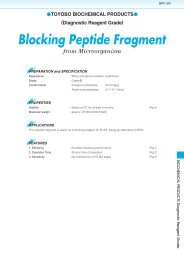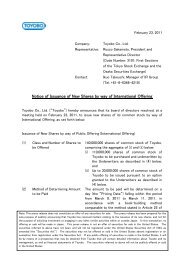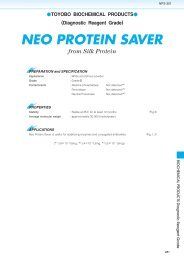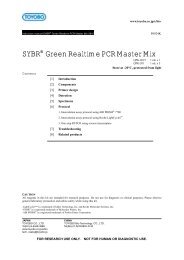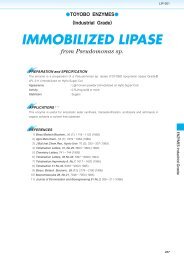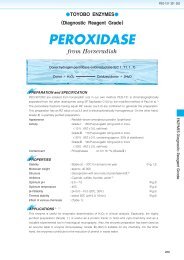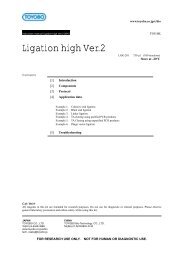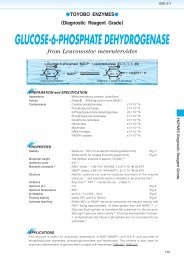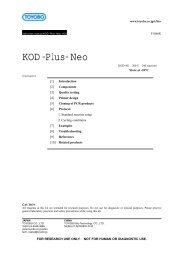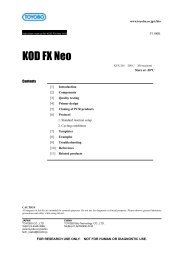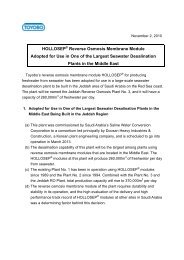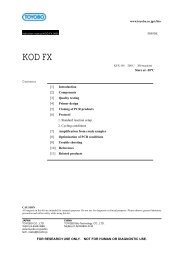GLUTAMATE DEHYDROGENASE (NAD-dependent) - Toyobo
GLUTAMATE DEHYDROGENASE (NAD-dependent) - Toyobo
GLUTAMATE DEHYDROGENASE (NAD-dependent) - Toyobo
- No tags were found...
You also want an ePaper? Increase the reach of your titles
YUMPU automatically turns print PDFs into web optimized ePapers that Google loves.
GTD-211<br />
TOYOBO ENZYMES<br />
(Diagnostic Reagent Grade)<br />
<strong>GLUTAMATE</strong> <strong>DEHYDROGENASE</strong><br />
(<strong>NAD</strong>-<strong>dependent</strong>)<br />
from Microorganism<br />
L-Glutamate : <strong>NAD</strong> oxidoreductase (deaminating)(EC 1. 4. 1. 2)<br />
L-GlutamateH 2 O<strong>NAD</strong> 2-OxoglutarateNH 3 <strong>NAD</strong>HH <br />
PREPARATION and SPECIFICATION<br />
Appearance<br />
: White amorphous powder, lyophilized<br />
Activity<br />
: Grade100 U/mg-solid or more<br />
Contaminants : <strong>NAD</strong> oxidase ≤1.010 2 %<br />
PROPERTIES<br />
Stability : Stable at 20 for at least one year Fig.1<br />
Molecular weight : approx. 260,000<br />
Isoelectric point : 5.6<br />
Michaelis constants<br />
: 9.2110 3 M (NH 3 ), 4.8010 3 M (-Ketoglutarate)<br />
7.810 5 M (L-Glutamate), 1.2910 4 M (<strong>NAD</strong>H), 5.8910 4 M (<strong>NAD</strong> )<br />
Structure<br />
: 6 subunits per mol of enzyme<br />
Inhibitors<br />
: Heavy metals, PCMB, IAA<br />
Optimum pH : 7.58.0 (-KGL-Glu) 9.0 (L-Glu-KG) Fig.2<br />
Optimum temperature : 55 (-KGL-Glu) 50 (L-Glu-KG) Fig.3<br />
pH Stability : pH 5.010.0 (25, 20hr) Fig.4<br />
Thermal stability : below 50 (pH 8.3, 10min) Fig.5<br />
Substrate specificity : (Table 1)<br />
Effect of various chemicals : (Table 2)<br />
APPLICATIONS<br />
This enzyme is useful for enzymatic determination of NH 3 , -ketoglutaric acid and L-glutamic acid, and<br />
for assay of leucine aminopeptidase and urease. This enzyme is also used for enzymatic determination<br />
of urea when coupled with urease (URH-201) in clinical analysis.<br />
133
GTD-211<br />
ASSAY<br />
Principle:<br />
-KetoglutarateNH 3 <strong>NAD</strong>HH glutamate dehydrogenase<br />
L-Glutamate<strong>NAD</strong> H 2 O<br />
The disappearance of <strong>NAD</strong>H is measured at 340nm by spectrophotometry.<br />
Unit definition:<br />
One unit causes the oxidation of one micromole of <strong>NAD</strong>H per minute under the conditions described below.<br />
Method:<br />
Reagents<br />
A. Buffer solution 0.1M Tris-HCl buffer, pH 8.3<br />
B. NH 4 Cl solution 3.3M<br />
C. -Ketoglutarate solution 0.225M (adjust the pH to 7.09.0 with NaOH)(Should be phepared fresh)<br />
D. <strong>NAD</strong>H solution 7.5mM (Should be prepared fresh)<br />
E. Enzyme diluent 0.1M Tris-HCl buffer, pH 8.3<br />
Procedure<br />
1. Prepare the following reaction mixture in a cuvette (d1.0cm)<br />
Concentration in assay mixture<br />
and equilibrate at 30 for about 5 minutes.<br />
Tris-HCl buffer<br />
86 mM<br />
2.5ml Buffer solution (A) -Ketoglutarate<br />
7.6 mM<br />
NH<br />
0.2ml NH 4 Cl solution (B)<br />
4 Cl<br />
0.22 M<br />
<strong>NAD</strong>H<br />
0.25mM<br />
0.1ml -Ketoglutarate solution (C)<br />
0.1ml <strong>NAD</strong>H solution (D)<br />
2. Add 0.05ml of the enzyme solution and mix by gentle inversion.<br />
3. Record the decrease in optical density at 340nm against water for 2 to 3 minutes in a spectrophotometer<br />
thermostated at 30, and calculate the OD per minute from the initial linear portion of the curve (OD<br />
test).<br />
At the same time, measure the blank rate (OD blank) by using the same method as the test except that<br />
the enzyme diluent (E) is added instead of the enzyme solution.<br />
<br />
Dissolve the enzyme preparation to 0.10.8U/ml with ice-cold diluent (E), immediately before assay.<br />
Calculation<br />
Activity can be calculated by using the following formula<br />
Volume activity (U/ml) <br />
OD/min (OD testOD blank)Vtdf<br />
6.221.0Vs<br />
Weight activity (U/mg)(U/ml)1/C<br />
Vt Total volume (2.95ml)<br />
Vs Sample volume (0.05ml)<br />
6.22 Millimolar extinction coefficient of <strong>NAD</strong>H at 340nm (F/micromole)<br />
1.0 Light path length (cm)<br />
df Dilution factor<br />
C Enzyme concentration in dissolution (c mg/ml)<br />
OD/min9.486df<br />
134
GTD-211<br />
Table 1. Substrate Specificity of Glutamate dehydrogenase<br />
Substrate (2mM)<br />
Relative activity<br />
Substrate (2mM)<br />
Relative activity<br />
L-Glutamate 100 L-Glutamine 0.05<br />
L-Norvaline 0.35 L-Aspartate 0.07<br />
L--Aminobutyrate 0.16 L-Asparagine 0.11<br />
L-Norleucine 0 L-Valine 0.09<br />
D,L-Homocysteine 0.06 L-Leucine 0.03<br />
L-Isoleucine 0.09 L-Alanine 0.07<br />
L-Methionine 0.06<br />
Glutamate dehydrogenase : 0.3U/ml of 0.1M Tris-HCl buffer, pH 9.0 <strong>NAD</strong> + :12mM<br />
Table 2. Effect of Various Chemicals on Glutamate dehydrogenase<br />
[The enzyme dissolved in 0.1M Tris-HCl buffer, pH 8.3 was incubated with each chemical at 25 for 1hr.]<br />
Chemical Concn.(mM)<br />
Residual<br />
activity<br />
None 100%<br />
Metal salt 2.0<br />
MgCl 2 97<br />
CaCl 2 99<br />
Ba(OAc) 2 101<br />
FeCl 3 1.8<br />
CoCl 2 97<br />
MnCl 2 78<br />
ZnSO 4 6.9<br />
Cd(OAc) 2 58<br />
NiCl 2 100<br />
CuSO 4 0.3<br />
Pb(OAc) 2 0.01<br />
AgNO 3 1.6<br />
HgCl 2 0<br />
PCMB 2.0 0.6<br />
MIA 2.0 98<br />
Chemical Concn.(mM)<br />
Residual<br />
activity<br />
NaF 2.0 100<br />
NaN 3 20 102<br />
EDTA 5.0 102<br />
o-Phenanthroline 2.0 101<br />
,´-Dipyridyl 2.0 102<br />
Borate 102<br />
IAA 2.0 0.2<br />
NEM 2.0 96<br />
Hydroxylamine 2.0 100<br />
Triton X-100 0.10% 102<br />
Brij 35 0.10% 103<br />
Tween 20 0.10% 101<br />
Span 20 0.10% 107<br />
Na-cholate 0.10% 103<br />
SDS 0.05% 0.1<br />
DAC 0.05% 0.2<br />
Ac, CH 3 CO; PCMB, p-Chloromercuribenzoate; MIA, Monoiodoacetate; NEM, N-Ethylmaleimide; IAA, Iodoacetamide;<br />
EDTA, Ethylenediaminetetraacetate; SDS, Sodium dodecyl sulfate; DAC, Dimethyl-benzyl-alkyl-ammonium chloride<br />
100<br />
100<br />
100<br />
Residual Activity,%<br />
50<br />
-20<br />
Relative Activity<br />
50<br />
Residual Activity, %<br />
50<br />
0<br />
0 5 10 15 20<br />
Period(months)<br />
0<br />
5 6 7 8 9 10 11<br />
pH<br />
0<br />
2 4 6 8 10 12<br />
pH<br />
Fig.1. Stability (Powder form)<br />
kept under dry conditions<br />
Fig.2. pH-Activity<br />
,-KG L-Glu;L-Glu -KG<br />
in 0.1M buffer solution:pH5.7-7.6<br />
K-phosphate,pH7.8-9.0,Tris-HCI; pH9.4-<br />
10.3, glycine-NaOH<br />
Fig.4. pH-Stability<br />
25, 20hr-treatment with 0.1M buffer solution:<br />
,acetate;,K-phosphate,Tris-HCI;<br />
glycine-NaOH<br />
100<br />
100<br />
Relative Activity<br />
50<br />
Residual Activity, %<br />
50<br />
0<br />
20 30 40 50 60 70<br />
Temperature, <br />
0<br />
20 30 40 50 60 70 80<br />
Temperature, <br />
Fig.3. Temperature activity<br />
,-KG L-Glu;0.1M Tris-HCI buffer<br />
pH8.3;,L-Glu -KG:0.1M Tris-HCI<br />
buffer,pH9.0<br />
Fig.5. Thermal stability<br />
10min-treatment with 0.1M Tris-HCI buffer,<br />
pH8.3<br />
135
GTD-211<br />
<br />
<br />
3 <br />
glutamate dehydrogenase<br />
2 <br />
<br />
<br />
<br />
<br />
<br />
<br />
4 <br />
<br />
<br />
<br />
<br />
P<br />
<br />
<br />
<br />
<br />
P <br />
P 4 <br />
P <br />
P <br />
P<br />
<br />
<br />
<br />
<br />
<br />
<br />
<br />
<br />
P<br />
P<br />
P <br />
<br />
P <br />
<br />
<br />
<br />
P<br />
136



